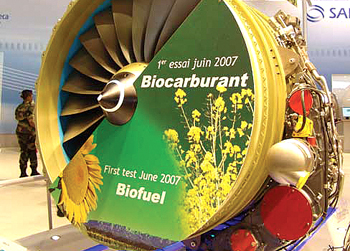Future Fuels - Green Salve to Price Sting

Biofuel’s appeal lies in that it burns somewhat cleaner than fossil fuel. But the key attraction is that instead of being a finite, shrinking energy source, it can be cultivated and is replaceable—or, in environmental jargon, sustainable.
Two major trends were discernible at Farnborough 2008. First, unlike in the past, airlines bleeding from high fuel prices did not appear quite as eager to oblige manufacturers with big orders. Second, seeing the writing on the wall, the aviation industry bent over backwards to proclaim its environment-friendly credentials, making sustainable aviation the new buzz. Whether much tangible action can be expected to shore up the green hype is another matter.
It is difficult to find an unqualified optimist in the commercial aviation industry today. The bad news from airlines all over the world just keeps pouring in: substantial losses, bankruptcy, even complete shutdowns. In India, steep increases in ticket prices are rapidly driving away discretionary travellers resulting in drastically curtailed growth this year and the very real threat of a contraction in the near future—this, after several years of double-digit expansion. The rampaging monster responsible for this dismal situation is the price of Aviation Turbine Fuel (ATF). Gloomy forecasts about days of $200 (Rs 9,711) per barrel prices raise the spectre of when, not if; think of an Israeli attack on Iran, for instance. However, with prices now receding on account of falling demand, there are more cheerful predictions of a crash to $75 (Rs 3,641) a barrel. It is permissible at least to dream of better times.
Whichever figure be correct, one thing is clear: the era of pumping cheap fossil fuel from under the ground as though there were no tomorrow is well and truly over. It even seems possible that the days of peak oil doomsayers may soon be here. Peak oil is the approximate point in time when the maximum rate of global petroleum production is reached, after which production enters a terminal decline. If global consumption is not controlled before the peak, an energy crisis could well develop because the availability of oil will drop rapidly and prices will rise, perhaps dramatically. During the current decade, very few new oilfields have been discovered and the existing ones are being overexploited. The percentage of low grade crude is increasing, requiring more refining. When the petroleum industry itself begins to talk about the need to develop alternative fuels surely it is time to sit up and take notice.
At the same time, there is increasing pressure on the aviation industry, especially in Europe, to drastically cut carbon emissions. The worldwide boom in the aviation sector, if the current slowdown is temporary, means that total Green House Gas (GHG) emissions due to aviation have increased by 25 per cent between 1996 and 2005 and are expected to touch a frightening 80 per cent by 2020, with a substantial proportion being at high altitudes where adverse environmental effects are intensified. Consequently, commercial aviation has the potential to become the main cause of human-induced climate change. The challenge is to keep the enormous economic benefits of air transport—8 per cent of world GDP and 32 million jobs at last count—while reducing or eliminating the environmental impact.





